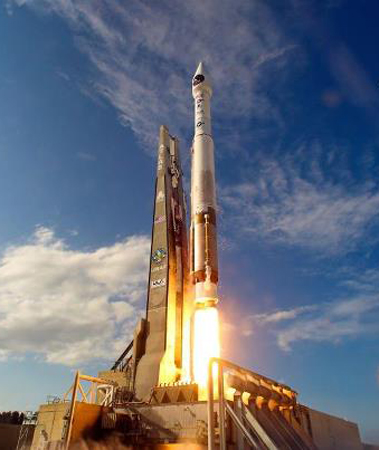The  Air Force and its industry partners on Tuesday launched, GEO-2, the second Space Based Infrared System satellite, into orbit atop a United Launch Alliance Atlas V booster fired from Cape Canaveral AFS, Fla. “The entire team worked hand-in-hand to make this another successful launch for the Air Force and our nation,” said 45th Space Wing Commander Brig. Gen. Anthony Cotton, who oversees Cape Canaveral launch operations, in a release. He added, “Our hats go off to them for all their hard work.” The satellite separated from the Atlas V upper stage approximately 43 minutes after the launch, which occurred at 5:21 p.m. US East Coast time, said service space acquisition officials in a separate release. It then began a series of orbital maneuvers to propel itself to a geosynchronous earth orbit. Once in its final orbit, engineers will deploy the satellite’s solar arrays and antennas and complete checkout and tests in preparation for operational use, states the release. GEO-2 joins GEO-1, which reached orbit in May 2011, and two SBIRS payloads that reside on classified intelligence satellites. The SBIRS constellation is designed to provide early warning of missile launches and other types of infrared surveillance information to the US military and intelligence community. They will complement, and eventually replace, legacy Defense Support Program satellites. Lockheed Martin is the SBIRS prime contractor; Northrop Grumman is the payload supplier. (See also Lockheed Martin release.)
Air Force and its industry partners on Tuesday launched, GEO-2, the second Space Based Infrared System satellite, into orbit atop a United Launch Alliance Atlas V booster fired from Cape Canaveral AFS, Fla. “The entire team worked hand-in-hand to make this another successful launch for the Air Force and our nation,” said 45th Space Wing Commander Brig. Gen. Anthony Cotton, who oversees Cape Canaveral launch operations, in a release. He added, “Our hats go off to them for all their hard work.” The satellite separated from the Atlas V upper stage approximately 43 minutes after the launch, which occurred at 5:21 p.m. US East Coast time, said service space acquisition officials in a separate release. It then began a series of orbital maneuvers to propel itself to a geosynchronous earth orbit. Once in its final orbit, engineers will deploy the satellite’s solar arrays and antennas and complete checkout and tests in preparation for operational use, states the release. GEO-2 joins GEO-1, which reached orbit in May 2011, and two SBIRS payloads that reside on classified intelligence satellites. The SBIRS constellation is designed to provide early warning of missile launches and other types of infrared surveillance information to the US military and intelligence community. They will complement, and eventually replace, legacy Defense Support Program satellites. Lockheed Martin is the SBIRS prime contractor; Northrop Grumman is the payload supplier. (See also Lockheed Martin release.)
F-35As from the Vermont Air National Guard have deployed to Puerto Rico in recent days, continuing a major buildup of U.S. Air Force assets in Latin America aimed at combating drug trafficking and pressuring the regime of Venezuelan leader Nicolas Maduro.

